The Brazos Performance Preview: AMD E-350 Benchmarked
by Anand Lal Shimpi on November 16, 2010 12:01 AM ESTMobile IGP Comparison
I narrowed down the platforms for our mobile IGP comparison. I simulated a Core i3 350M by taking an i3-530, underclocking it (I couldn't do anything about the 4MB vs. 3MB L3 cache) and capping its GPU frequency at 667MHz. This is the best case scenario for the i3-350M, and as you'll see below, it doesn't really matter. I also paired a 2.2GHz Pentium Dual-Core with a G45 motherboard, agian simulating the cheaper mobile Pentium platform. Finally I installed Windows 7 on the 1.6GHz Core 2 Duo based 11-inch MacBook Air with its GeForce 320M to give you an idea of the upper bound for mobile performance with what might as well be a low end discrete GPU.
Updated: I've added performance results from a simulated Core i3-330UM, the E-350's competition in ultra portables.
We'll start with Modern Warfare 2:
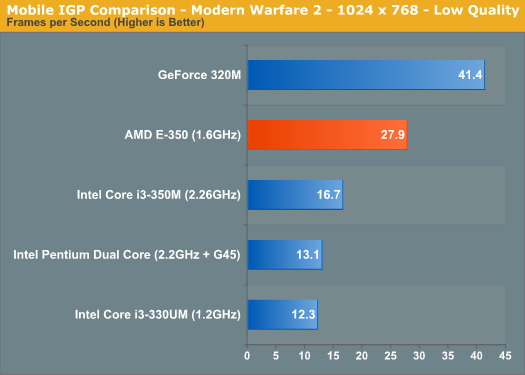
The E-350 puts the i3-350M, i3-330UM and Pentium DC to shame, delivering 67% better performance. The frame rate is just shy of being totally smooth however. I found that in most modern games 1024 x 768 would result in frame rates just under 30 fps.
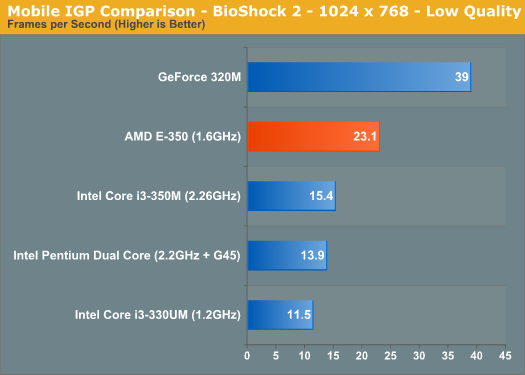
BioShock 2 showed a similar performance advantage. Again we're not able to break 30 fps but the performance advantage is huge compared to the Intel platforms with integrated graphics.
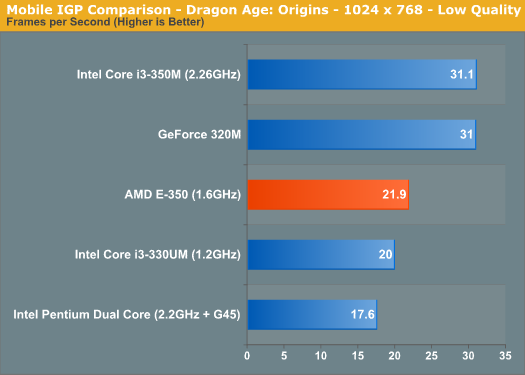
Dragon Age: Origins is mostly CPU bound at low quality settings and thus there's no real advantage to the E-350's Radeon HD 6310 GPU. It's faster than the Pentium/G45 platform, but significantly slower than the i3-350M. I expect most games however to be GPU bound at these settings across the board.
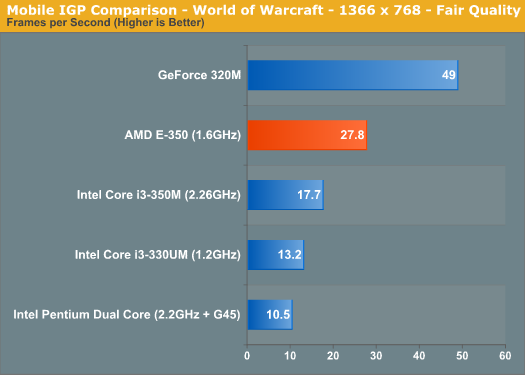
World of Warcraft continued the trend. The E-350 ended up 57% faster than the i3-350M, although still fell short of a discrete GPU.
Of course I wondered how well Brazos would play Starcraft 2:
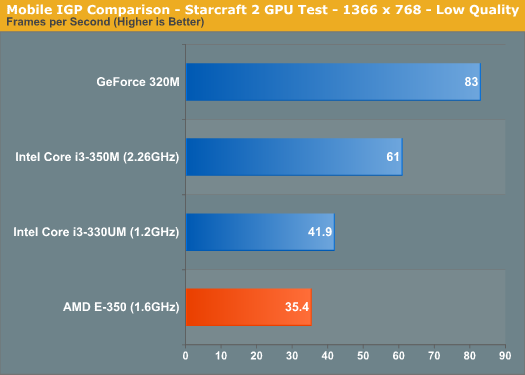
The GPU handles SC2 just fine, however the game is very CPU dependent and thus you see a pretty big advantage from the mainstream i3 system. The comparison is a lot closer when we look at the i3-330UM. The E-350 won't be able to play SC2 as well as a $500 mainstream notebook, but it'll be comparable to an ultraportable running ULV Arrandale.
We don't have numbers for the G45 platform here because the system wouldn't run our benchmark (our tests use an older version of SC2 which apparently had issues with the G45 drivers).
Our SC2 CPU test gives you an idea of the lower end of performance in large multiplayer battles:

The E-350 offers only 58% of the performance of the i3-350M system. The Bobcat cores do hold the platform back from time to time. Again, compared to the i3-330UM there's no performance difference at all.
Just for kicks I also ran the Civilization V benchmark, which gave us two datapoints: GPU performance and no-render/CPU performance.
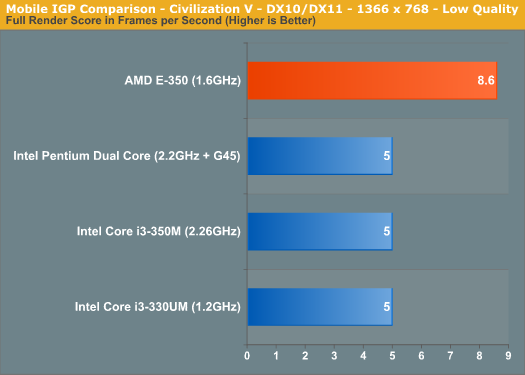
The benchmark doesn't score well on either platform, although AMD does hold a 72% performance advantage over the i3 and G45 platforms. The CPU test puts the E-350 at about 55% of the speed of the Pentium dual core platform.
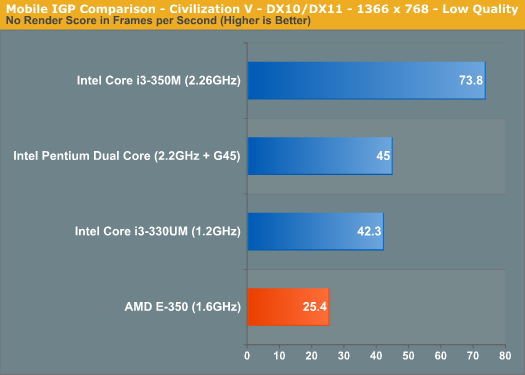
Civ V is one area where the Arrandale CPU advantage wins out over GPU performance.
Overall, the E-350 has no problems outperforming any of the current Intel integrated graphics offerings in 3D games. In CPU bound titles the E-350 loses out to the mainstream i3, but is competitive with ultra low voltage i3s. Just as with Atom, you'll have to sacrifice performance vs. a mainstream notebook, but compared to low voltage Arrandale the E-350 can hold its own.










207 Comments
View All Comments
duploxxx - Tuesday, November 16, 2010 - link
TDP doesn't mean real world power consumption, I think you should look at a few other reviews first who did a better compare.... Zacate even owns atom 525 big time with ION and even better then single core atom.... what TDP again? :)http://hothardware.com/Reviews/AMD-Zacate-E350-Pro...
NST - Tuesday, November 16, 2010 - link
No, it isn't.E-350 has the same number of cores as I7-680UM(top of the line Intel CULV Processor that is supposedly available but nowhere to be found), higher frequency, better IGP and it comes at a far cheaper price.Also, Sandy Bridge, at its launch, won't bring new CULV chips, because the current line has been out for less than 6 months.So, no more competition for this segment.
8steve8 - Tuesday, November 16, 2010 - link
NST im not sure what your point is, yes the E350 has the same number of cores and the same TDP as all core i3/i5/i7 ULV parts, I'm not sure about price but they can be found in a variety of laptops, from the lenovo u160,u260,u460s, .... well almost every mfgr has a shipping laptop with a core iX ulv part (sans apple).laptops with these parts have been purchasable since june, and the e350 is only benchmarkable via an engineering platform... so its not exactly that close to market... even if it was.. seems like it can't compete vs core ix ulv. on anything other than price.
maybe if its super-cheap, it'll sell in a few netbooks vs atom.
NST - Tuesday, November 16, 2010 - link
1. E-350 has much better power consumption.2. E-350 has better GPU performance.
3. Intel CULVs are based on a better architecture however, E-350 has a higher frequency, which is crucial for 720p gaming.
As a gamer, what I see here is the potential for ultraportable notebooks with gaming performance close to this of Alienware M11x and never before seen battery life at the cost of an Atom-based netbook.
I do not question Intel's current supremacy in every segment but I think that next year Intel will face some strong competition from AMD.And that's good for us customers.
mino - Tuesday, November 16, 2010 - link
And you forgot the most important point - Brazos is playing in a completely different price bracket.The Atom price bracket.
Dark_Archonis - Tuesday, November 16, 2010 - link
Brazos is aiming at the $300-500 market. Guess what, there are some Celeron systems that fall in that price bracket as well.8steve8 - Tuesday, November 16, 2010 - link
1. does it have much better power consumption? the tdp's are the same, ive yet to see ulv arrandale vs e350, total system power consumption.2. yes, it has better gpu performance
3. the e350 has higher non-turbo frequencies than ulv arrandales, but why do you think that's crucial for 720p gaming... by that logic the 3.6Ghz pentium 4 is better suited for gaming than a 3Ghz sandy bridge cpu... which is false.
NST - Wednesday, November 17, 2010 - link
1.All you got to do is check the review of a laptop featuring an Arrandale ULV chip and then compare the power consumption.There plenty out there.Plus AMD stated that E-350's idle power consumption would be even lower in the final product.3. 720p gaming--->More CPU dependant
1080p, 1600p etc--->More GPU dependant
Generally about gaming, in higher resolutions, GPU becomes more and more important than the CPU.What I meant was that in a game that utilizes 2 cores E-350 will have an edge due to the higher frequency.And yes, if you find a game that utilizes only one CPU core (probably an old one) the Pentium will probably manage to hold his own against Sandy Bridge.
Khato - Wednesday, November 17, 2010 - link
1. How about the ~10W consumption of the Alienware M11x R2 while running the Anandtech Internet battery life test? That's a i7-640UM that'll ramp up to 2.27GHz when it's needed.With respect to other power consumption figures... It's mildly annoying how other sites are typically comparing desktop/'nettop' systems to the 'brazos' demo platform. After all, take a look at the power consumption of any actual notebook/netbook implementation of the same processors and suddenly the power consumption numbers of the 'brazos' demo platform is simply in line/above the competition rather than far below it...
If interested in other power numbers, the Anandtech "Intel Core 2 CULV Roundup" published earlier this year has some good figures for both atom and CULV. For example, the Asus 1005PE with the single-core atom N450 at 1.66GHz consuming a massive 9.5 watts under 100% CPU load. So theoretically an N550 with its 3 watt higher TDP would get up to all of 12.5 watts... Of course more interesting is the fact that the 1.3GHz CULV notebooks in that review are at all of 19 watts under 100% CPU load - so comparable power consumption, despite being faster and on a 45nm process tech instead of 40nm (though the Intel 45nm is roughly equal to TSMC 40nm, if not better.)
mino - Tuesday, November 16, 2010 - link
Do you see those ULV chips selling for Atom prices as Zacate and Ontario are ?You are comparing an enduro to a moped while complaining the latter is slower.
Hell it is. IT IS SUPPOSED TO BE.
The fact that Zacate is actually considered an alternative to ULV series at 1/3 the cost is a HUGE success on itself.